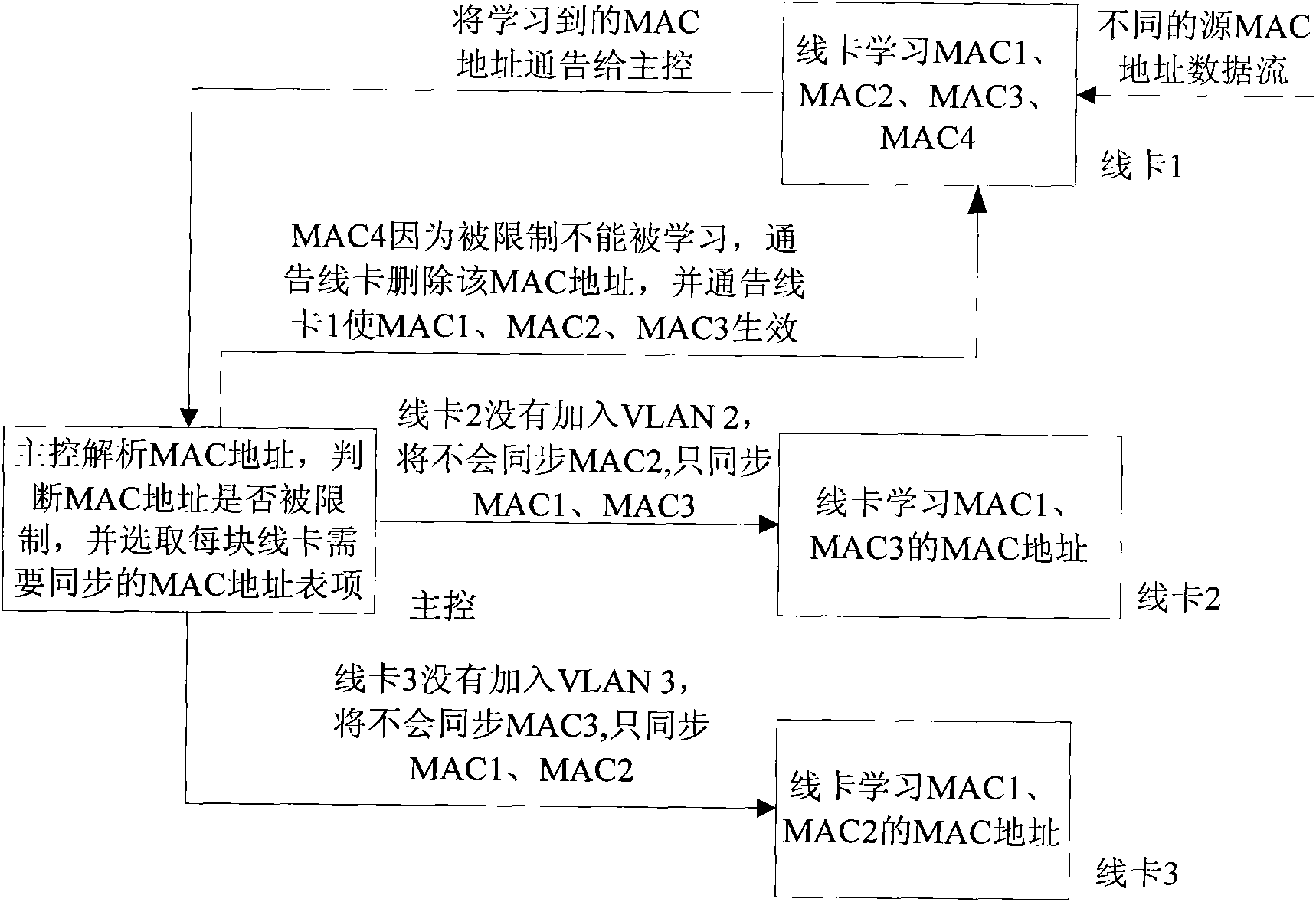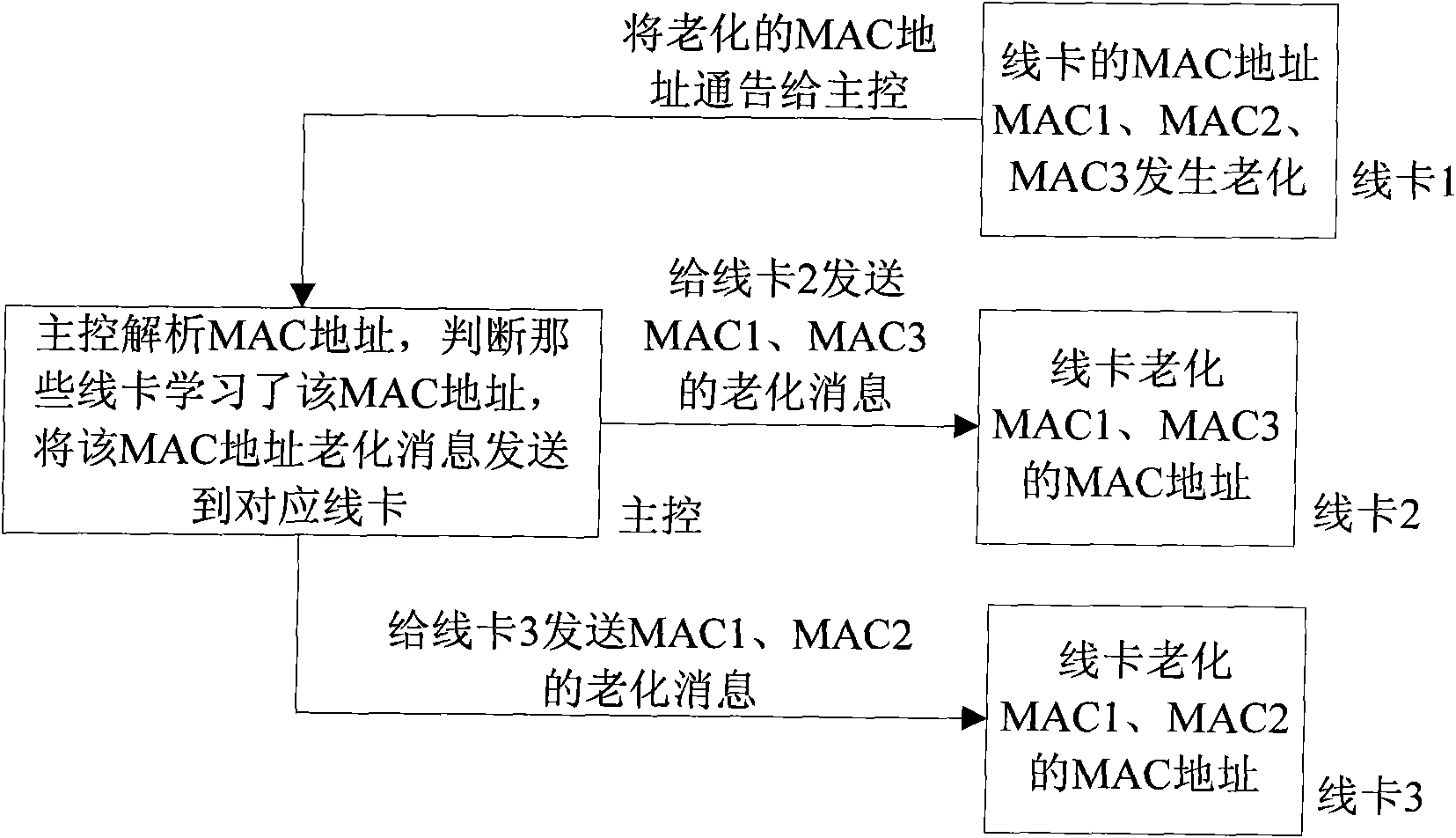Conditional synchronization method for MAC address table entry of distributed switch
A MAC address table and MAC address technology, applied in the field of conditional synchronization of MAC address table items in distributed switches, can solve problems such as wasting system resources
- Summary
- Abstract
- Description
- Claims
- Application Information
AI Technical Summary
Problems solved by technology
Method used
Image
Examples
Embodiment 1
[0053] Embodiment 1: Regarding the learning of MAC address entries, refer to the flow chart figure 2 shown
[0054] Step 101: Line card 1 is added to VLAN1, 2, 3, and 4 respectively, and the switch chip of line card 1 learns the four MAC addresses of MAC1 from VLAN1, MAC2 from VLAN2, MAC3 from VLAN3, and MAC4 from VLAN4. entry.
[0055] Step 102: the line card 1 packs the 4 MAC address entries and sends them to the main control for learning processing.
[0056] Step 103: After receiving the learning data packet of the MAC address entry, the main control parses the content of the data packet, and judges each MAC address entry.
[0057] Step 104: the main control judges that the MAC address learning in VLAN4 has been restricted, so MAC4 will not be learned, and the main control sends back the message of deleting MAC4 to line card 1, so that line card 1 deletes the MAC address entry; The main control determines that the other three MAC address entries need to be synchronized,...
Embodiment 2
[0062] Embodiment 2: For the aging of MAC address entries, refer to the flow chart image 3 shown
[0063] Step 201: After the MAC address entries of line card 1: MAC1, MAC2, and MAC3 age out, line card 1 directly deletes the three MAC address entries MAC1, MAC2, and MAC3, and notifies the CPU of line card 1 to process them.
[0064] Step 202: The CPU of the line card 1 sends the aging messages of the three MAC address entries MAC1, MAC2, and MAC3 to the main control CPU.
[0065] Step 203: After receiving the aging message, the main control CPU deletes the local MAC address entries, and determines which MAC address entries need to be aged by other line cards.
[0066] Step 204: After the main control determines that the line card 2 needs to age the two MAC address entries MAC1 and MAC3, the main control sends an aging message of the two MAC address entries MAC1 and MAC3 to the line card 2.
[0067] Step 205: After the main control determines that the line card 3 needs to ag...
Embodiment 3
[0069] Embodiment 3: Regarding the processing of line card VLAN information changes, refer to the flow chart Figure 4 shown
[0070] Only when the VLAN information in the MAC address entry belongs to the VLAN table of the line card, the MAC address entry will be synchronized to the line card. The VLAN information of the line card is determined according to the status of adding the port on the front panel of the line card to the VLAN.
[0071] Step 301: after one of the front panel ports of line card 2 is added to VLAN2 through a configuration command, line card 2 is also added to VLAN2 at this time. After the line card 2 is added to VLAN2, the main control CPU sends a message to the main control MAC address management module. After receiving the message, the main control MAC address management module searches for all local MAC address entries about VLAN2.
[0072] Step 302: the main control sends the MAC address entry MAC2 to the line card 2, so that the line card 2 learns ...
PUM
 Login to View More
Login to View More Abstract
Description
Claims
Application Information
 Login to View More
Login to View More - R&D
- Intellectual Property
- Life Sciences
- Materials
- Tech Scout
- Unparalleled Data Quality
- Higher Quality Content
- 60% Fewer Hallucinations
Browse by: Latest US Patents, China's latest patents, Technical Efficacy Thesaurus, Application Domain, Technology Topic, Popular Technical Reports.
© 2025 PatSnap. All rights reserved.Legal|Privacy policy|Modern Slavery Act Transparency Statement|Sitemap|About US| Contact US: help@patsnap.com



